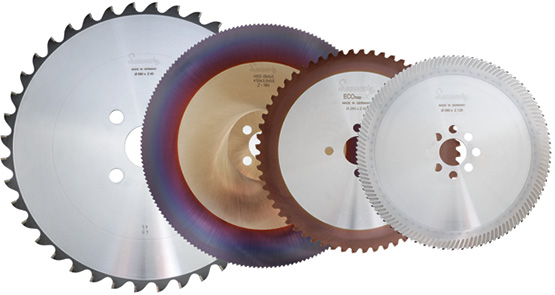
Hot and friction circular saw blades

LENNARTZ hot and friction circular saw blades up to 2,500 mm in diameter are high-performance tools made of tried and tested special tempered steels with a strength of 850 to 950 N/mm2. Hot and friction circular saw blades are used for the cutting of slabs, billets, sheet metals, tubes and profiles. Hot circular saw blades are used for cutting material temperatures > 850°C, whereas friction circular saw blades are used for cutting material temperatures < 250°C. The fusion cutting separation principle is used for both separation processes. Thereby, frictional heat is generated in the work area of the tool, which is almost close to the melting temperature of the material. This requires a cutting speed of VC = 100-140 m/sec. A sufficient press water cooling in the tooth region must be ensured, in order to flush out residual material from the tooth base. Depending on the cutting task, a feed rate of Vf = 80-2.000 mm/min. can be achieved.
Common tooth geometries

Pendulum saw tooth
γ0/α0 = 30° suitable for the hot and cold cutting of pipes, profiles, beams and solid material

Special version with
tooth-tip hardening

Parrot tooth
γ0 = 0° α0 = 8° suitable for the cold cutting
of pipes, profiles and beams
Versions

D = saw blade diameter (mm)
ap = cutting width (mm)
B = medium bore diameter (mm)
C = flange diameter (mm)
Version 1: Rolling black sides
Version 2: Side surfaces ground even
Version 3: Side surfaces ground radial conical
Special tooth geometry

Carbide-tipped
Use in the hot cutting area: Tubes and profiles, steel cutting
Advantages:
- Service life increase up to tenfold compared to previous methods
- Economical sawing
- Ridge-free cuts
T = tooth pitch (mm)
α0 = clearance angle
γ0 = rake angle
ap = cutting width (mm)
The design of the optimal tooth geometry and the tooth pitch is determined by the cross section of the material to be cut, the cutting material grade and the separating layer. An increase of the cutting volume Q (cm3/min) is achieved through a tempering of the tools to 1,200 - 1,250 N/mm2 (saw blade diameters up to 1000 mm) or through a tooth-tempering up to a Rockwell hardness of C 58.
